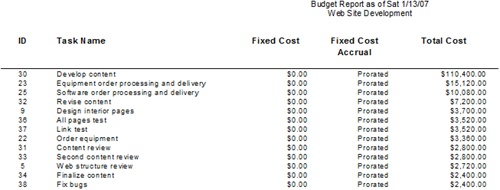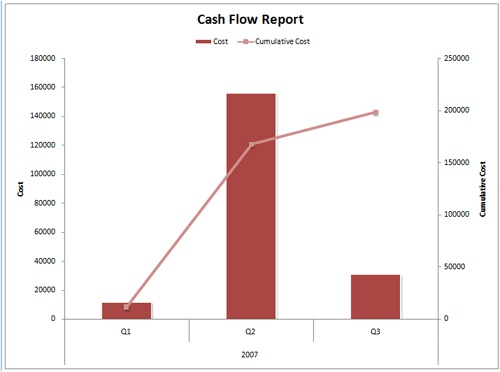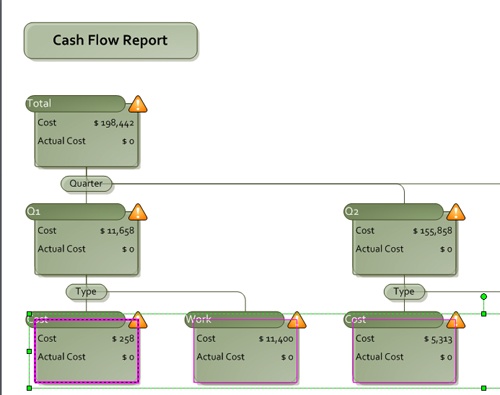A budget-constrained project is one in which costs are the most important factor in the project plan. Although you still need to balance schedule requirements and satisfy the project scope, in such a project the costs are at the forefront of your decision-making processes as you plan and execute the project.
If your project plan calculates that your total costs are above the allowed budget, you need cost-cutting strategies. Your best approach will involve cutting resources because resources and costs are virtually synonymous in projects. As described in the previous section, when you want to bring in the finish date, you focus on tasks in the critical path. In the same way, when you want to cut costs, you focus on resources to gain the biggest cost savings.
Review your cost picture first, compare it with your budget, and then make any necessary adjustments.
To review total project costs using Project Statistics, do the following:
You can review costs for tasks and summary tasks when you apply the Cost table to a task sheet. If you show the project summary task to a sheet with the Cost table applied, you can see the total project cost as well. To apply and analyze costs in the Cost table, follow these steps:
Click View, Table, Cost. The Cost table is applied.
Click Tools, Options and then click the View tab.
Under Outline Options, select the Show Project Summary Task check box and then click OK.
The project summary task row appears at the top of the task sheet. The total project cost, as currently scheduled, is displayed in the Total Cost field.
Review the Total Cost field for summary tasks. This is the rolled-up total of all assigned resource costs and fixed costs for the subtasks.
Review the Total Cost field for individual tasks. This is the sum of all assigned resource costs as well as fixed costs for tasks.
If you are using the new budget resource type with the new Budget Work and Budget Cost fields, you can group and review predetermined budget values against your planned project costs.
Note
For information about how to create and assign budget resources, enter budget values, and align resources with their corresponding budget resources, see the section titled Setting Up and Reviewing a Project Budget in Chapter 8.
To group and compare resource costs against budget values, follow these steps:
Switch to the Resource Usage view.
Add the Budget Work, Budget Cost, Work, and Cost fields to the table. Right-click the column to the right of where you want to insert the column and then click Insert Column on the shortcut menu. In the Field Name box, scroll to and select the field and then click OK.
Click Project, Group By, Customize Group By.
In the Group By field under Field Name, select the name of the text field that you’re using to categorize your resources. Depending on how you set up your budget categories, this could be a custom text field, the Code field, or the Group field.
Click OK.
The resources in your project are grouped by the budget categories you assigned. Each grouping includes one budget resource. The figures for the budget resource appear in the Budget Cost and Budget Work fields. The figures for all other resources appear in the Cost and Work fields. The total costs for the resources are rolled up in the grouping bar. Compare those rolled up values against the values for the budget resources to see how the costs in your project are faring against the budget for that category.
To ungroup the Resource Usage view, click Project, Group By, No Group. Or, on the Standard toolbar, in the Group By tool, click No Group.
Five cost reports can help you analyze planned project costs, as follows:
Budget report. Click Report, Reports. Double-click Costs and then double-click Budget. The Total Cost column is a summary of the resource costs and fixed costs for each task (see Figure 9-16).
Cash Flow report. Click Report, Reports. Double-click Costs and then double-click Cash Flow. This report forecasts the funding needed for each period of time, enabling you to see whether budgeted costs will be exceeded at a particular point.
Cash Flow visual report in Excel. Click Report, Visual Reports. In the Task Usage tab, double-click Cash Flow Report. Microsoft Office Excel 2007 opens to show the project’s cash flow in a column chart (see Figure 9-17).
Cash Flow visual report in Visio. Click Report, Visual Reports. In the Resource Usage tab, double-click Cash Flow Report (Metric) or Cash Flow Report (US). Visio opens to show the project’s cash flow in a Visio PivotDiagram (see Figure 9-18).
You can sort a sheet view by costs. To review task or resource costs in order of amount, do the following:
You can filter a sheet view to display only tasks or resources that have costs exceeding a specified amount. To do this, follow these steps:
Display a task sheet or resource sheet, depending on whether you want to see costs by resource or by task.
Click View, Table, Cost.
Click Project, Filtered For, More Filters.
In the More Filters dialog box, click Cost Greater Than and then click Apply.
In the Cost Greater Than dialog box, enter the amount (see Figure 9-19).
Figure 9-19. To see only those tasks or assignments that have a scheduled cost exceeding a certain amount, enter the amount in this dialog box.
To see all tasks or all resources again, click Project, Filtered For, All Tasks or All Resources.
If you find that your scheduled costs are higher than your budget, first review the individual costs themselves. Check the resource rates as well as fixed costs for tasks and make sure they’re accurate.
To check resource rates, review the Resource Sheet with the Entry table applied. With the default fields in the Entry table, you can see each resource’s standard rate, overtime rate, and cost per use.
To check fixed costs for tasks, review a task sheet such as the Gantt Chart with the Cost table applied. The Fixed Cost field displays any costs associated with the tasks that are independent of resource costs.
If many of your resource costs are based on time periods such as an amount per hour or per day, you might be able to cut costs if you can reduce task durations. For example, suppose you have a 2-day fixed-units task assigned to a $100/hour resource. By default, this resource is assigned to 16 hours of work, for a cost of $1,600. If you reduce the duration to 1 day, the work is reduced to 8 hours, and the cost is reduced to $800.
When you reduce task duration in a fixed-units or fixed-duration task, the amount of work is also reduced. However, if you reduce duration for a fixed-work task, work stays the same and assignment units increase. In this case, resource costs would not be reduced.
Note
For more information about changing durations, see the section titled Checking and Adjusting Durations earlier in this chapter.
Another way to reduce work and therefore cut costs is to reduce work directly. In effect, you’re cutting the amount of time that resources are spending on assigned tasks.
The manner in which a work reduction affects your task and resource scheduling depends on the individual task types. When you decrease work in a fixed-units or fixed-work task, duration is reduced. When you decrease work in a fixed-duration task, units are decreased.
To change work amounts for individual resources, display the Task Usage view or Resource Usage view. Then edit the Work field for the assignment.
You might be using cost resources in your project; that is, those cost items that contribute to the completion of a task but—unlike work or material resources—do not affect the schedule when assigned to that task. The ability to integrate cost resources is a new feature in Project 2007. Examples of cost resources include airfare, lodging, and rentals.
To review the amounts planned for cost resources, switch to the Resource Usage view. Apply the Cost table by clicking View, Table, Cost. If you only want to see cost resources, click Project, Filtered For, Resources – Cost.
You can now review the costs for each cost resource. If you need to make any adjustments, you can change the Cost field for the assignment under the cost resource.
Note
You can also adjust scope to cut costs. For more information about cutting scope, see the section titled Changing Project Scope later in this chapter.




